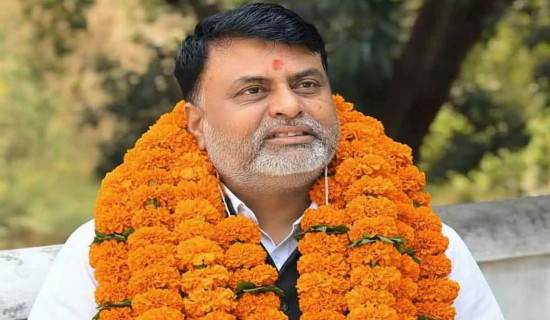- Thursday, 16 October 2025
Mashta Devta Tradition Of West Nepal
For Nepalis, the Himalaya is itself the centre of divinity and is honoured as a form of god. There are different cultural diversities living in the south face, hilly region, and Terai as well. Mashto culture is one of them, preserved in western and far western Nepal at present as well. Normally, people use the word Mashto; devotees name this god in honour as Mashta. Mashta is called the king of earth, the son of the main Vedic god Indra. Some writers wrote that Mashta is the Khasa people's god. This is not true. Khasa people were renamed around the eleventh century of the Vikram era. Mashta has been worshipped for many thousand years in almost all parts of west Nepal by a large number of populations.
There is similarity between the cultures of Uttarakhand (India) and West Nepal. There, this god is called Moshta. Indra's son appointed a king to look after this earth. If there is no rain, people request Moshta, worshipping with homa. There are examples where it rains within a few hours.
This is an original tradition of Nepal, in the parallel line of the Himalayan range. There are signs of the presence of this god in Myanmar in the east and Pakistan in the west. This god is worshipped in different forms and names according to different traditions.
Mashta god is of only two types of form. One is taking offerings of milk, called Dudhe Mashta, and another harsh form is called Darhe Mashta. The first is in the kingship role, and the second is in executive form. This creates a complete form of Mashta, a divine kingdom. In Mashto civilization, Mashta is the supreme god.
Some writers have classified Mashta god into 12 types. They have classified, giving this god's helpers name. They are given local names like Lakuda, Latahit, Langa, Bathpala, and others. They work under the command of Mashta god. Hindus honour the Veda as their holy book. Mashta god is related to Veda. God Bathpala, working under the command of Mashta, is the Veda reader. When Bathpala takes possession of man (dhami), he chants the Veda Hymn fluently. He continues for two or three hours. The dhami may be of any caste; it is not necessary to be a Brahmin. If there is no rain or overraining, people worship Mashta god. As a god of the environment, Mashta controls the weather. Mashto culture does not create any group or community, and there is no division of society. It is humans' daily behaviour.
In Sudur Paschim and Karnali provinces, worship is performed in the form of homa. This is an offering to the fire of mixed havan material of sesame, ghee, and barley. The puja method has been practiced in recent years in the same way that it was in ancient times. The gods accept no puja method other than homa. If done, it is worthless. In the eastern part of Nepal, some people worship this god in the name of Kulayan.
For worship, there is no need to get costly materials. Devotees can offer according to their capacity. So, worship is also performed in groups in the villages. They contribute the things in small quantities, and they are big when collected. Worship can be done at any time, once a year, or at a favourable time.
Devta possesses the Dhami (god possessing man), and there is conversion with human beings directly. Before possessing god, Dhami has to pass different tests. The words Dhami and Jhankri are different. Dhami takes possession of him and behaves on behalf of god. Jhankri is a person chanting a magic mantra called a shaman. Shamanism is different and not applicable to this culture. Mandus are also built with a simple structure. These gods do not need any extra-ordinary type of temple. Devata's presence in Mandu is important.
These developers work in normal situations without any charisma. Creating any abnormal incident unnecessarily is against nature's rules. They simply support the lives of people, protecting family members from danger. They encourage you to work hard. If anyone is doing farming, it needs water. They provide water when it rains. In animal husbandry, they protect animals from disease. They help support devotees in trade and employment.
These gods have certain rules and regulations that humans must obey to get their blessings. Every person is required to obey these rules. In failure, they have to incur anger. These dieties punish those committing the crime. No one can go unpunished, at any cost. No book can cure the sin of doing a bad job. So, they warn their devotees to remain according to nature's system.
People believe that god destroys everything at once. It is not true; they show the effect of their anger slowly. It is said that the effect of Mashta's anger is seen after 12 years, and if this God is satisfied, the effect of that crime ends completely after 18 years. So, it is better to remain far from the anger of the gods.
In the Veda, it is written that gods always remain the same, whether they are young or old. They never give birth or die. But now a days, some so-called lords are taking birth and dying after living a full life. In Mashta culture, after taking birth, if they die, they are called pitri (dead ancestors). These pitri are untouchable to the gods and remain far from their behaviour.
In Mashta culture, no idol is worshipped. For the god's presence, any signs like a crystal stone, bell, flag, or others can be used. Mashta is the brother of the goddesses, and he addresses their sister. That is why some gods refer to him as Mama (maternal uncle).
This culture does not need any propaganda, highlights, or publishing. There are fag songs that are passed down orally from one generation to the next. It continued with the hearsay from the people of each generation from one to another.
(The author is a Mashto culture writer.)















